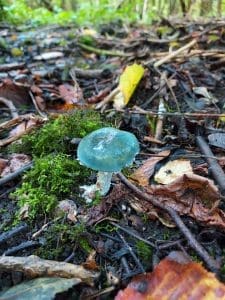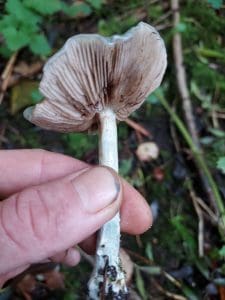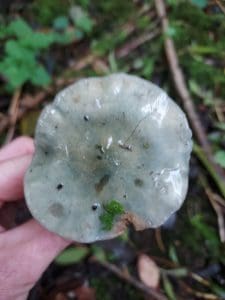Blue Roundhead / Summer / Autumn / Inedible
The Blue Roundhead (Stropharia caerulea) is a captivating with its striking blue-green hues. Commonly found in grassy areas, woodchips, and leaf litter across Europe and North America, this eye-catching fungus stands out due to its vivid colouration and distinctive round cap.
The Blue Roundhead features a smooth, slimy cap that can range from bright blue to greenish-blue, with a sturdy white stem adorned with a delicate ring.
As a member of the Strophariaceae family, this mushroom plays a crucial role in decomposing organic matter and enriching soil health.
In this blog post, we will delve into the unique characteristics of the Blue Roundhead, provide tips for identifying it in the wild, and discuss its ecological importance.
Scientific Name
Stropharia caerulea
Common Names
Blue Roundhead
Family
Strophariaceae
Habitat
Blue Roundheads are considered a saprobic fungus (collecting nutrients from consuming rotting organic matter) so are commonly found developing in small groups.
Description
A common find this fungi loves beech woodlands, but can also be discovered growing in grasslands and heaths.
Physical Characteristics:
Cap
As the name suggests, a good identifying feature for this mushroom is its blue coloured cap, presenting more yellowy green hues in the centre as they age. The shape of the cap is convex on young species, which turns into a bell-shaped cap just before it flattens out as they fully mature. It has a slimy exterior ( which can dry out in the sun) with possibly a few white scales as the young mushrooms grow out of their veils.

Gills
The adnate gills are whitish brown and light in colour when young. As they age, they get darker and can develop more purple tones.

Stem
The scales on this mushroom continue up the stem starting at the base but are interrupted by a ring, leftover from the veil. Near the exposed gills, the stem should be smooth in appearance.
Smell:
No strong aroma
Spores:
Purple/brown
Uses:
In food:
Inedible – causes stomach upset.
Known hazards
This species can cause gastric upset and should be considered unsafe for consumption.
This mushroom was once thought to contain psilocybin and psilocin. A single study reported finding these substances in S. caerulea, but later analyses have not confirmed this, suggesting the earlier result was likely an error.
Potential lookalikes:
The Blue Roundhead (Stropharia caerulea) can be mistaken for several other mushrooms due to its distinctive blue-green colouration and habitat. Here are some common look-alikes:
Verdigris Agaric (Stropharia aeruginosa) has a similar blue-green colour, slimy cap, but this is much rarer and often has white veil remnants on the cap margin.
The Parrot Waxcap (Gliophorus psittacinus) again has a bright green to yellowish-green cap, often with a slimy texture, and a slender stem but is smaller, with a more delicate and slender stem, and often displays a wider range of colours, including yellows and oranges as it ages. Unlike the Blue Roundhead, it lacks a stem ring and is typically found in mossy or grassy habitats rather than woodchips or leaf litter.
Edible Uses:
Inedible – causes stomach upset.
Other Facts:
Research in the past has pointed to this mushroom as containing compounds which cause hallucinations, but this was proven to be incorrect in more recent studies.






